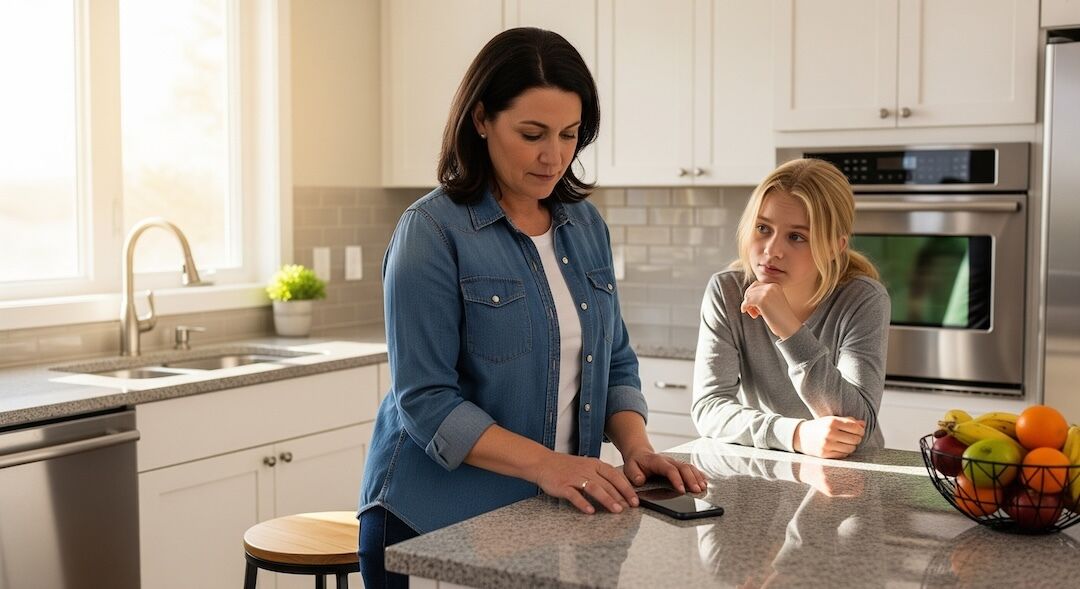Have you noticed how teens bounce between cat videos, sneaker hauls and conspiracy clips faster than they take out the trash? We parents grew up in an era when television ended at midnight and ads were obvious sales pitches. Our kids, on the other hand, carry a world of content in their pockets 24/7, and it’s impacting them in ways we’re only starting to understand. A recent study of more than 100,000 young adults found that kids who got their own smartphone before age 13 reported more aggression, detachment and even suicidal thoughts later in life. Nearly half of girls who received smartphones at age 5 or 6 reported severe suicidal ideation. Researchers say early smartphone ownership shapes how kids think and view the world.
That doesn’t mean we need to banish phones altogether, but it does mean we have to do more than just set screen‑time limits. Dr. Natasha Burgert, a pediatrician and mom herself, reminds us that our kids learn from watching us. If we’re glued to our phones, they will be too. She advises parents to model healthy habits by connecting authentically with their kids each day and by showing them that the humans in front of us deserve more attention than the devices in our hands.
So how do we teach kids to think critically about what they see online? The American Academy of Pediatrics suggests families follow the “5 C’s” of media use. Here’s how I use them at home:
Child – Pay attention to your child’s temperament and interests. Some kids are drawn to dance videos and harmless memes; others become obsessed with unrealistic luxury unboxings. Tailor your rules and discussions to what they’re consuming and how it affects their mood. When my son started following a “get‑rich‑quick” influencer, we sat down together and researched how that influencer actually made money (hint: it wasn’t by day‑trading).
Content – Encourage kids to question content. Ask them who created it and why. Is it entertainment, advertising, or misinformation? Teach them to spot #ad labels and to realise that influencers are being paid to promote certain lifestyles. My daughter now loves pointing out when a YouTuber slips in a sponsored smoothie.
Calm – Help kids manage emotions. TikTok’s algorithm thrives on keeping them scrolling when they’re bored or stressed. Create digital‑free zones and suggest other ways to decompress. We have a rule that homework and chores come before screen time, and Saturday mornings are for chores, books or going outside.
Crowding out – Make sure screens aren’t replacing quality time. Sit down to dinner without devices. Cook a meal together. Let them earn their own spending money by doing chores through apps like ForChore instead of just watching unboxing videos. Understanding the value of money starts with doing real work.
Communication – Keep talking. Ask what they saw on Instagram today. Share your own experiences with ads and scams. Remind them that social media is highlight reels, not reality. When my teen was convinced everyone at school owned the latest shoes, a quick budget chat—and a trip to a thrift store—helped reset her expectations.
Finally, consider delaying that first smartphone. Experts from the same study recommend waiting until age 14 and using simpler devices like flip phones for calls or texts. Whatever you decide, remember that parenting in the digital age isn’t about policing every tap but about raising thoughtful, media‑savvy humans. If we teach our kids to question, evaluate and prioritise real‑world connections, they’ll be better equipped to navigate influencers, ads and everything the internet throws at them.
Sources:
Good Morning America – Kids who own smartphones before age 13 have worse mental health outcomes: Study (July 22, 2025)







Leave a Reply
You must be logged in to post a comment.